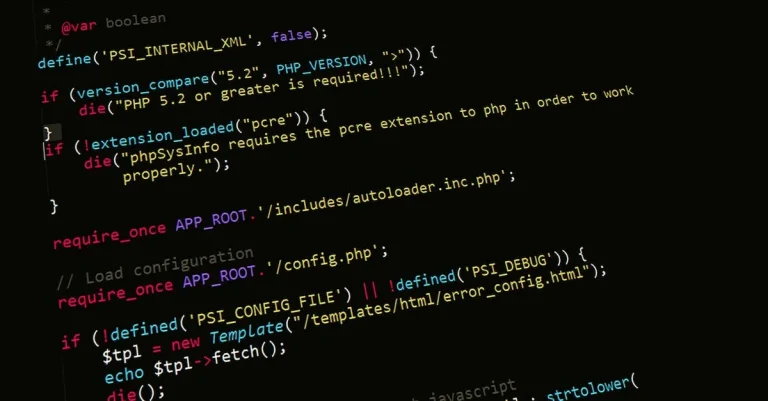What Is An Algorithm In Computer Science?
From social media feeds to navigation apps, algorithms shape our digital experiences. But what exactly are these mysterious lines of code that have become integral to modern life? Understanding algorithms is key to unlocking the foundations of computer science.
If you’re short on time, here’s a quick answer: An algorithm in computer science is a set of instructions or rules designed to solve a problem or complete a computation.
In this comprehensive guide, we’ll dig into everything you need to know about algorithms. You’ll learn how they work, the different types, and their essential role in powering our technology. With examples like search engine results, recommendations, and artificial intelligence, you’ll gain an appreciation for these ingenious sequences of steps that make our digital world possible.
Defining Computer Algorithms
In computer science, an algorithm is a set of instructions or a step-by-step procedure for solving a particular problem or accomplishing a specific task. It is like a recipe that guides a computer on how to perform a certain operation.
Algorithms are the building blocks of computer programs and are essential for various applications in fields such as artificial intelligence, data analysis, and software development.
Sequence of Instructions
An algorithm consists of a sequence of instructions that are executed in a specific order. These instructions can be simple or complex, depending on the problem being solved. They can include operations such as arithmetic calculations, data manipulation, conditional statements, and loops.
By following the algorithm, the computer can perform the necessary computations and produce the desired output.
Solving Problems Methodically
One of the key purposes of algorithms is to solve problems in a methodical and efficient manner. By breaking down a complex problem into smaller, more manageable steps, algorithms allow programmers to tackle the problem systematically.
This approach not only helps in identifying the most optimal solution but also makes it easier to understand, debug, and modify the code as needed.
For example, imagine a scenario where you need to sort a list of numbers in ascending order. By using an algorithm such as the popular “Bubble Sort,” you can compare adjacent elements and swap them if they are in the wrong order.
By repeating this process multiple times, the list gradually becomes sorted. This step-by-step approach ensures that the sorting is done correctly and efficiently.
Automating Computational Thinking
Algorithms play a crucial role in automating computational thinking. They enable computers to perform complex tasks that would otherwise be time-consuming or nearly impossible for humans to accomplish manually.
By providing a clear set of instructions, algorithms allow computers to analyze large amounts of data, make decisions, and carry out repetitive tasks with precision and speed.
For instance, in the field of data analysis, algorithms are used to extract valuable insights from vast datasets. They can identify patterns, make predictions, and provide recommendations based on the available data.
This automation of computational thinking empowers businesses and researchers to make data-driven decisions and gain a competitive edge in their respective fields.
To learn more about algorithms in computer science, you can visit websites like GeeksforGeeks or Coursera that offer comprehensive resources and courses on this topic.
Key Features of Algorithms
Inputs and Outputs
One of the key features of algorithms is that they have inputs and outputs. In computer science, inputs are the data or values that are given to the algorithm, while outputs are the results or solutions that the algorithm produces.
These inputs and outputs can take different forms, depending on the specific problem that the algorithm is designed to solve. For example, an algorithm for sorting numbers would take a list of unsorted numbers as input and produce a sorted list as output.
Definite Sequence
Another important feature of algorithms is that they follow a definite sequence of steps. This means that there is a specific order in which the instructions or operations in the algorithm are carried out.
The sequence of steps ensures that the algorithm performs the desired computations or actions in a systematic and organized manner. Without a definite sequence, the algorithm may not produce the correct results or may not terminate at all.
Finiteness
An algorithm must also have finiteness, which means that it must eventually terminate after a finite number of steps. This is important because it ensures that the algorithm does not run indefinitely and consume excessive resources.
The termination of an algorithm can be achieved through conditions or stopping criteria that are defined within the algorithm. For example, an algorithm for searching a specific item in a list may terminate when the item is found or when the entire list has been searched.
Effectiveness
Effectiveness is a crucial feature of algorithms, as it refers to the ability of an algorithm to solve a problem in a reasonable amount of time. An effective algorithm should be efficient and not take an excessively long time to produce the desired results.
The efficiency of an algorithm can be evaluated based on factors such as its time complexity and space complexity. Time complexity measures the amount of time it takes for an algorithm to run, while space complexity measures the amount of memory or storage it requires.
Precision
Lastly, an algorithm must be precise and unambiguous. This means that the instructions or operations in the algorithm should be clearly defined and leave no room for interpretation. Ambiguity in an algorithm can lead to incorrect results or unexpected behavior.
Precise algorithms ensure that the desired computations or actions are carried out accurately and consistently.
Types of Algorithms
Search Algorithms
Search algorithms are used to find a particular item or element in a collection of data. These algorithms are designed to efficiently search through large amounts of data to locate the desired item. One of the most commonly used search algorithms is the binary search algorithm.
This algorithm works by repeatedly dividing the search space in half until the desired item is found.
Other popular search algorithms include the linear search algorithm and the depth-first search algorithm. The linear search algorithm checks each element in the collection sequentially until the desired item is found.
On the other hand, the depth-first search algorithm explores each branch of a tree-like data structure until the item is found or all branches have been exhausted.
Sorting Algorithms
Sorting algorithms are used to arrange elements in a specific order, such as ascending or descending. These algorithms are essential in various applications, including data analysis, database management, and computational biology.
One of the most well-known sorting algorithms is the quicksort algorithm. This algorithm divides the collection into smaller sub-arrays based on a pivot element and recursively sorts each sub-array.
Other popular sorting algorithms include the mergesort algorithm, which divides the collection into smaller sub-arrays and then merges them back together in the correct order, and the insertion sort algorithm, which iteratively places each element in its proper position within a growing sorted sub-array.
Data Compression Algorithms
Data compression algorithms are used to reduce the size of data files while preserving its integrity and quality. These algorithms are widely used in applications such as file compression, image compression, and video compression.
One of the most commonly used data compression algorithms is the Huffman coding algorithm. This algorithm assigns shorter codes to frequently occurring symbols and longer codes to less frequent symbols, resulting in overall data compression.
Another popular data compression algorithm is the Lempel-Ziv-Welch (LZW) algorithm. This algorithm replaces frequently occurring sequences of characters with shorter codes, resulting in efficient compression. The LZW algorithm is commonly used in file formats such as GIF and TIFF.
Computer Graphics Algorithms
Computer graphics algorithms are used to generate and manipulate visual content on computer screens. These algorithms play a crucial role in various applications, including video games, computer-aided design (CAD), and virtual reality.
One of the fundamental computer graphics algorithms is the Bresenham’s line algorithm. This algorithm efficiently determines which pixels to turn on in order to draw a straight line on a raster display.
Another important computer graphics algorithm is the Phong shading algorithm. This algorithm calculates the illumination of a surface by considering the light sources, material properties, and viewer’s position, resulting in realistic shading and highlighting effects.
For more information on algorithms, you can refer to the GeeksforGeeks website, which provides detailed explanations and implementations of various algorithms in computer science.
Algorithm Design and Analysis
In computer science, algorithm design and analysis are crucial aspects of developing efficient and effective programs. An algorithm is a step-by-step process or set of rules that a computer follows to solve a specific problem or perform a task.
It is essentially a blueprint that outlines the necessary actions and decisions required to achieve a desired outcome.
Step-by-Step Development Process
When designing an algorithm, a programmer must break down the problem into smaller, more manageable steps. This process involves carefully considering the inputs, outputs, and operations involved in solving the problem.
By breaking it down, a programmer can develop a clear and logical sequence of instructions that the computer can execute.
For example, let’s say you want to develop an algorithm to find the sum of all numbers in a given list. The steps might include:
- Initialize a variable to hold the sum.
- Iterate through each number in the list.
- Add the current number to the sum.
- Repeat until all numbers in the list have been processed.
- Return the final sum.
Evaluating Time and Space Complexity
When analyzing an algorithm, programmers consider two key factors: time complexity and space complexity. Time complexity refers to the amount of time it takes for an algorithm to run, while space complexity refers to the amount of memory or storage space an algorithm requires.
Programmers often use big O notation to express the time and space complexity of an algorithm. This notation provides a standardized way to compare the efficiency of different algorithms. For example, an algorithm with a time complexity of O(n) will generally be faster than one with a time complexity of O(n^2) for large input sizes.
Improving Performance
One of the main goals of algorithm design and analysis is to optimize performance. By carefully analyzing the time and space complexity of an algorithm, programmers can identify areas for improvement and make changes to enhance efficiency.
There are various techniques for improving algorithm performance, such as using more efficient data structures, implementing parallel processing, or eliminating redundant computations. These optimizations can significantly speed up the execution of an algorithm and reduce resource usage.
It’s important to note that algorithm design and analysis are ongoing processes. As technology advances and new challenges arise, programmers continue to refine and develop new algorithms to meet the ever-changing demands of computer science.
Algorithms in Action
An algorithm is a step-by-step procedure or a set of rules that are followed to solve a specific problem. In computer science, algorithms are the backbone of various applications and systems. Let’s explore how algorithms are utilized in different areas of computer science.
Artificial Intelligence and Machine Learning
In the realm of artificial intelligence (AI) and machine learning (ML), algorithms play a crucial role in enabling computers to learn and make intelligent decisions. These algorithms analyze large datasets, identify patterns, and make predictions based on the data.
For example, in image recognition, algorithms can detect objects, faces, and even emotions with astonishing accuracy. Additionally, algorithms power recommendation systems, allowing platforms like Netflix and Amazon to suggest personalized content to their users.
Operating Systems
Operating systems rely on algorithms to manage and coordinate various tasks and resources. Scheduling algorithms determine the order in which processes are executed, ensuring efficient utilization of the system’s resources.
Algorithms also handle memory management, ensuring that processes have access to the necessary memory space. File systems use algorithms to organize and retrieve data efficiently. Without these algorithms, operating systems would struggle to provide the smooth user experience we are accustomed to.
Computer Networks
In computer networks, algorithms are used to optimize the flow of data and ensure efficient communication between devices. Routing algorithms determine the best path for data packets to travel across a network, considering factors such as latency, bandwidth, and congestion.
Network security algorithms detect and prevent unauthorized access, protecting sensitive information. These algorithms enable the seamless transfer of data across the internet and are vital for the functioning of modern communication systems.
Database Systems
Algorithms are at the core of database systems, allowing efficient storage, retrieval, and manipulation of data. Search algorithms enable users to find specific information quickly, even in massive databases.
Sorting algorithms arrange data in a specific order, making it easier to analyze and retrieve. Additionally, algorithms ensure data integrity and consistency, preventing errors and maintaining the reliability of the database.
Without these algorithms, managing and accessing large amounts of data would be a daunting task.
Algorithms are the driving force behind many technological advancements in computer science. They enable computers to perform complex tasks, make intelligent decisions, and provide efficient solutions.
Whether it’s in the field of AI and ML, operating systems, computer networks, or database systems, algorithms are essential components that power modern computing.
Conclusion
From powering search engines to driving recommendation systems, algorithms permeate our digital experiences even if we don’t always realize it. By breaking complex problems down into logical, step-by-step solutions, they enable feats of automation and analysis that form the core of computer science.
Understanding how algorithms work provides insight into our technology-driven world and appreciation for the ingenuity behind computing innovations we use every day.







